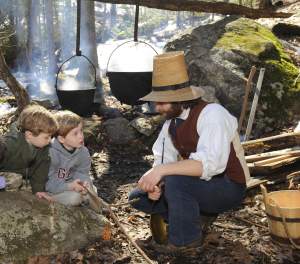

Summer is quickly coming to an end, but there is still time to get outdoors and explore history! The Village will be open for all of Labor Day Weekend.
Monday, September 2, 2024
See our artisans making handcrafted items from iron, tin plate, clay, leather, and wood. Our farmers and gardeners are tending to the gardens and seasonal chores, and of course, our farm animals always enjoy a visitor too. Enjoy your visit!
Daily Activities
10:00 a.m. & 1:30 p.m. A Guided Tour of the Salem Towne House: Tour a prosperous farmer’s home with a costumed historian (meets in the hallway of the Salem Towne House, Building #15).
11:00 a.m. Pirate Tales From New England’s Rocky Shores: Stories about swashbuckling – but nasty – pirates
(in the Gebhardt Barn, Building #13).
12:00 p.m. Read Me a Story – A read aloud story for children (in the Salem Towne House Garden, #15).
2:30 p.m. Living By the Bell: A role character presentation about a boardinghouse mistress’ experiences with the Lowell factory girls and the labor strikes of the 1830s (in the Salem Towne House Garden, #15).
3:30 p.m. Milking Demonstration
(at the Freeman Barn, near Building #34).
3:30 p.m. A Reading of New England Poetry: Poems by Longfellow, Thoreau, and other early 19th century poets
(in the Salem Towne House Garden, #15).
Trades
Shoe Shop (Building #9) Find a shoemaker “bottoming” men’s and boy’s work shoes for wholesale to the Southern and Western states. Some of the shoes for the South were meant for enslaved workers.
Blacksmith Shop (Building #37) Our smiths are hard at work making tools for our new cabinetmaking shop as well as more typical items.

End of Summer
September may mean back-to-school time for modern-day scholars in the United States, but that wasn’t always the case. In early 19th-century rural New England, school terms were typically three months in the winter and three months in the summer. Older children sometimes only attended winter term, since they might be needed for summer work on the farm.
Students ranging in age from about 3 or 4 to 16 would attend school in one-room buildings like the District Schoolhouse (c.1810) now at the Village. By this time, there were numerous free or nearly free schoolhouses in New England. The literacy rate in early 19th-century New England is estimated to be somewhere in the 90th percentile! Of course, all these estimates of literacy rates are just that – estimates. Some historians question the representativeness of samples used and what reading level is considered “literate.”
Game Time!
Throughout the Village, kids and adults alike enjoy playing old-fashioned games like les graces, battledore and shuttlecock, trundling hoops, and more. Many days, we also have a game of 19th-century baseball for guests to take part in!
These simple games are a fun respite from the digital world for all ages.